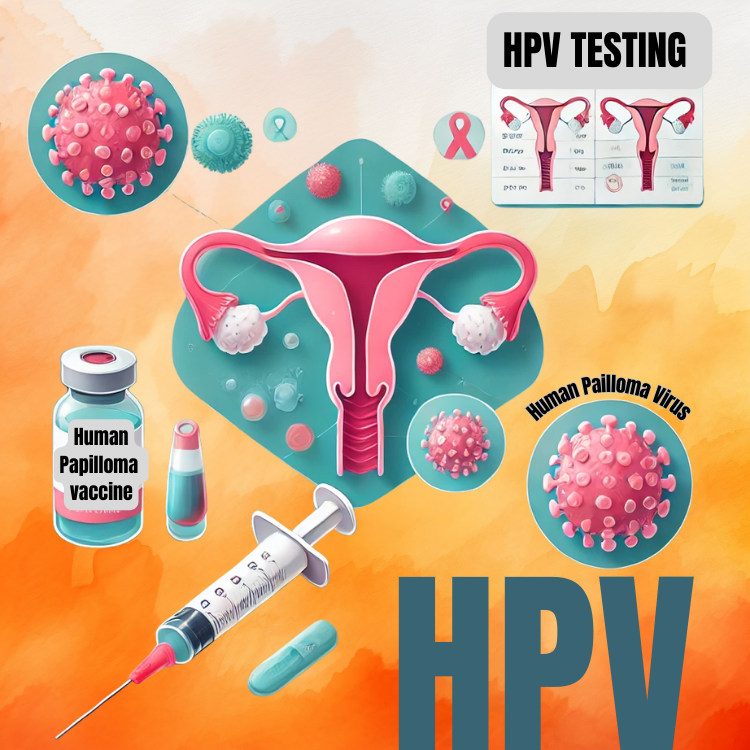
Human Papillomavirus (HPV) is a common viral infection with a significant impact on public health, particularly in relation to cervical cancer and other diseases. Let’s break down everything you need to know about HPV—what it is, its types, associated conditions, vaccines, and prevention strategies.
What Is HPV?
Human Papillomavirus (HPV) is a DNA virus from the papillomavirus family. It infects epithelial cells, which are the cells that make up the surface of your skin and mucous membranes (like the cervix, throat, and genital areas). HPV is incredibly common—most sexually active people will encounter it at some point in their lives. While many infections resolve on their own, certain types can cause significant health issues.
Structure of HPV

HPV is a small, non-enveloped virus with a simple but effective structure:
- Capsid (Protein Shell):
- The virus is surrounded by a protective protein shell, called the capsid, which is made of 72 capsomeres arranged in an icosahedral (20-sided) shape. This shell helps the virus attach to and enter human cells.
- DNA Genome:
- Inside the capsid is the virus’s genetic material: a circular double-stranded DNA genome about 8,000 base pairs long.
- The genome is organized into early (E) and late (L) regions:
- Early (E) Genes: Control viral replication and interactions with host cells.
- Late (L) Genes: Encode proteins for the capsid structure.
- No Lipid Envelope:
- Unlike some viruses, HPV lacks a lipid envelope, which makes it more resistant to environmental conditions.
This simple structure allows HPV to efficiently infect cells and evade detection by the immune system.
Nature of HPV Infection
HPV is an epithelial-tropic virus, meaning it specifically targets epithelial cells. Here’s how it works:
- Entry:
- The virus enters the body through tiny cuts or abrasions in the skin or mucosa.
- Infection:
- HPV infects the basal layer of epithelial cells, where it replicates and produces viral proteins.
- Latency or Persistence:
- In some cases, HPV remains latent (inactive) in the body, causing no symptoms.
- Persistent infection, particularly with high-risk types, can lead to cellular changes and health problems over time.
Types of HPV
There are over 200 types of HPV, each with its own characteristics. These are generally classified into two categories:
1. Low-Risk HPV Types
- These types do not cause cancer but can lead to other conditions like genital warts or benign growths.
- Common Low-Risk Types:
- HPV-6 and HPV-11: Responsible for about 90% of genital warts and cases of recurrent respiratory papillomatosis (RRP).
2. High-Risk HPV Types
- These are associated with cancers, particularly cervical cancer. Persistent infection with these types can cause abnormal cell changes, which may progress to cancer if untreated.
- Common High-Risk Types:
- HPV-16: The most common high-risk type, responsible for 50-60% of cervical cancer cases.
- HPV-18: Causes another 10-15% of cervical cancers.
- Other high-risk types include HPV-31, HPV-33, HPV-45, and HPV-52.
Health Problems Caused by HPV
- Cancers:
- Cervical Cancer:
- HPV is the primary cause of cervical cancer, responsible for nearly 99% of cases. High-risk types like HPV-16 and HPV-18 cause about 70% of cervical cancers.
- Other HPV-Related Cancers:
- Oropharyngeal Cancer: Cancer of the throat, tonsils, and base of the tongue.
- Anal Cancer.
- Penile Cancer.
- Vulvar and Vaginal Cancers.
- Cervical Cancer:
- Genital Warts:
- Caused by low-risk HPV types like HPV-6 and HPV-11. These are non-cancerous but can be uncomfortable and emotionally distressing.
- Recurrent Respiratory Papillomatosis (RRP):
- A rare condition where benign growths develop in the airways, caused by HPV types like HPV-6 and HPV-11.
HPV Vaccines
The introduction of HPV vaccines has been a game-changer in preventing HPV-related diseases.
- Available Vaccines:
- Gardasil 9: Protects against nine HPV types (HPV-6, 11, 16, 18, and others associated with cancers and genital warts). It’s the most widely used vaccine today.
- Cervarix: Protects against HPV-16 and HPV-18, specifically for cervical cancer prevention (less commonly used now).
- How Vaccines Work:
- The vaccines use virus-like particles (VLPs) to stimulate the immune system. They do not contain live virus, so they cannot cause infection.
- They are most effective when given before exposure to HPV, typically before the onset of sexual activity.
- Vaccination Recommendations:
- American Academy of Pediatrics (AAP) and ACOG Recommendations:
- Routine vaccination is recommended for boys and girls at age 11-12, but it can be given as early as age 9.
- Catch-up vaccination is recommended up to age 26 for those who missed earlier doses.
- Adults aged 27-45 may discuss vaccination with their healthcare provider, particularly if they are at risk for new HPV exposure.
- American Academy of Pediatrics (AAP) and ACOG Recommendations:
- Dosage Schedule:
- 2 doses: For those who start the vaccine series before their 15th birthday.
- 3 doses: For those who start the series at age 15 or older or have a weakened immune system.
HPV and Cervical Cancer
HPV is directly linked to nearly all cases of cervical cancer. Here’s how it develops:
- Infection:
- High-risk HPV types infect cervical cells during sexual activity.
- Persistence:
- While most infections are cleared by the immune system, some persist, leading to abnormal cell changes.
- Precancerous Lesions:
- Persistent HPV can cause dysplasia, or precancerous changes in cervical cells, detectable via a Pap smear.
- Cancer Development:
- If left untreated, these changes can progress to invasive cervical cancer over years.
Screening for HPV and Cervical Cancer
- Pap Smear (Papanicolaou Test): (see post on Pap – https://montanaobgyn.com/what-is-a-pap-smear-and-why-its-so-important/)
- A test that collects cervical cells to check for abnormalities.
- Recommended starting at age 21, with screening every 3 years for women aged 21-29.
- HPV Testing:
- Detects the presence of high-risk HPV types.
- For women aged 30-65, co-testing (Pap smear + HPV test) every 5 years is recommended.
- Colposcopy: (see post on colposcopy – )
- A closer examination of the cervix, recommended if a Pap smear or HPV test is abnormal.
Treatment for HPV-Related Conditions
- Cervical Dysplasia:
- Cryotherapy: Freezing abnormal cells.
- LEEP (Loop Electrosurgical Excision Procedure): Removing abnormal tissue.
- Cone Biopsy: Removing a cone-shaped section of tissue for more advanced cases.
- Genital Warts:
- Treated with topical medications, cryotherapy, or surgical removal.
- Cancers:
- Managed with a combination of surgery, radiation therapy, and chemotherapy, depending on the stage and location.
Prevention of HPV
- Vaccination:
- The most effective way to prevent HPV-related cancers and genital warts.
- Safe Practices:
- Use condoms to reduce HPV transmission (though they don’t provide full protection).
- Limit the number of sexual partners to reduce exposure risk.
- Routine Screening:
- Regular Pap smears and HPV testing ensure early detection and treatment of precancerous changes.
This video on HPV is really interesting: https://youtu.be/pyihsgc209Q?si=o9YLvTDd2Tz6rO31
The Bottom Line
HPV is a common virus with serious potential consequences, but it’s also highly preventable. Vaccination, routine screening, and safe practices are key tools in reducing HPV-related diseases, especially cervical cancer. With widespread education and access to healthcare, we can significantly reduce the impact of HPV and protect future generations.
